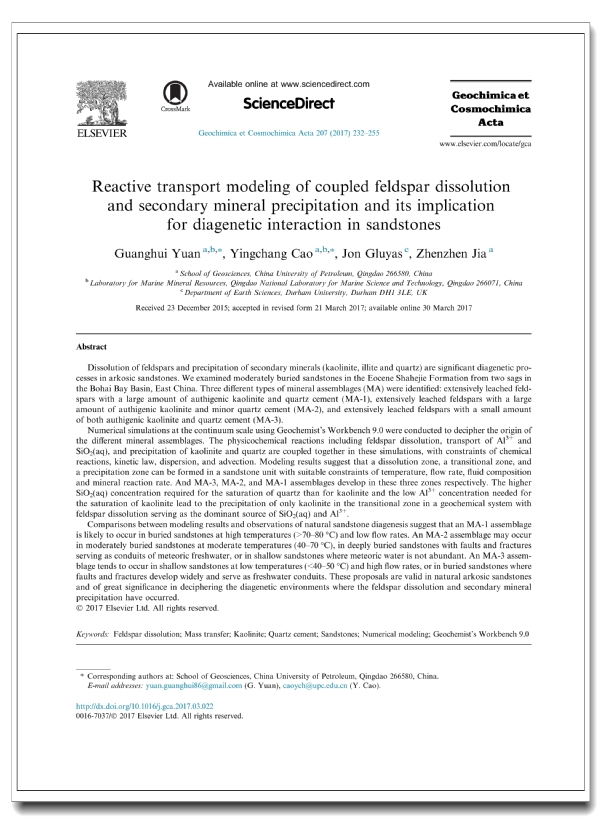Guanghui Yuan, Yingchang Cao, Jon Gluyas, Zhenzhen Jia,
Reactive transport modeling of coupled feldspar dissolution and secondary mineral precipitation and its implication for diagenetic interaction in sandstones,
Geochimica et Cosmochimica Acta,
Volume 207, 2017, Pages 232-255, ISSN 0016-7037,
https://doi.org/10.1016/j.gca.2017.03.022
Abstract: Dissolution of feldspars and precipitation of secondary minerals (kaolinite, illite and quartz) are significant diagenetic processes in arkosic sandstones. We examined moderately buried sandstones in the Eocene Shahejie Formation from two sags in the Bohai Bay Basin, East China. Three different types of mineral assemblages (MA) were identified: extensively leached feldspars with a large amount of authigenic kaolinite and quartz cement (MA-1), extensively leached feldspars with a large amount of authigenic kaolinite and minor quartz cement (MA-2), and extensively leached feldspars with a small amount of both authigenic kaolinite and quartz cement (MA-3). Numerical simulations at the continuum scale using Geochemist’s Workbench 9.0 were conducted to decipher the origin of the different mineral assemblages. The physicochemical reactions including feldspar dissolution, transport of Al3+ and SiO2(aq), and precipitation of kaolinite and quartz are coupled together in these simulations, with constraints of chemical reactions, kinetic law, dispersion, and advection. Modeling results suggest that a dissolution zone, a transitional zone, and a precipitation zone can be formed in a sandstone unit with suitable constraints of temperature, flow rate, fluid composition and mineral reaction rate. And MA-3, MA-2, and MA-1 assemblages develop in these three zones respectively. The higher SiO2(aq) concentration required for the saturation of quartz than for kaolinite and the low Al3+ concentration needed for the saturation of kaolinite lead to the precipitation of only kaolinite in the transitional zone in a geochemical system with feldspar dissolution serving as the dominant source of SiO2(aq) and Al3+. Comparisons between modeling results and observations of natural sandstone diagenesis suggest that an MA-1 assemblage is likely to occur in buried sandstones at high temperatures (>70–80°C) and low flow rates. An MA-2 assemblage may occur in moderately buried sandstones at moderate temperatures (40–70°C), in deeply buried sandstones with faults and fractures serving as conduits of meteoric freshwater, or in shallow sandstones where meteoric water is not abundant. An MA-3 assemblage tends to occur in shallow sandstones at low temperatures (<40–50°C) and high flow rates, or in buried sandstones where faults and fractures develop widely and serve as freshwater conduits. These proposals are valid in natural arkosic sandstones and of great significance in deciphering the diagenetic environments where the feldspar dissolution and secondary mineral precipitation have occurred.


